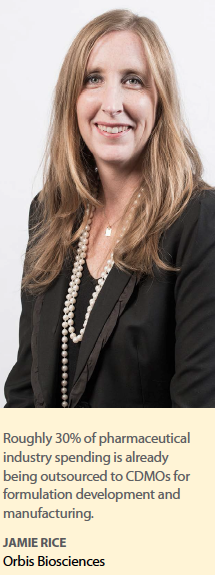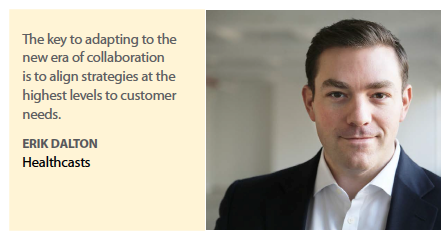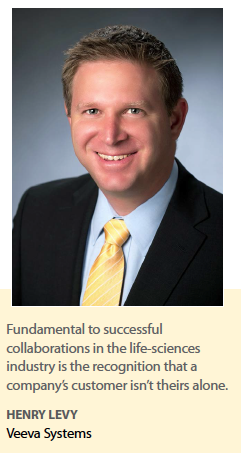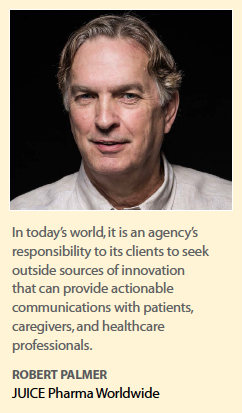In 2009, PwC predicted that the pharma business model would evolve to a more patient-centric and collaborative approach by the year 2020. Three years from that deadline, there is plenty of evidence that the industry has started to collaborate both inside and  outside of the “traditional" industry to help speed discovery and bring drugs to market in a more cost-efficient way. According to PwC, in order to prosper in today’s environment, companies need to continue to improve R&D productivity, reduce costs, and switch from selling medicines to managing outcomes, and this can be done with the right collaborating partners.
outside of the “traditional" industry to help speed discovery and bring drugs to market in a more cost-efficient way. According to PwC, in order to prosper in today’s environment, companies need to continue to improve R&D productivity, reduce costs, and switch from selling medicines to managing outcomes, and this can be done with the right collaborating partners.
The report encouraged the industry to explore joining forces with a wide range of organizations, from academic institutions, hospitals, and technology providers to companies offering compliance programs, stress management, and other health benefits, and to implement these partnerships across the entire business spectrum.
And that is just what is happening. Pharma companies are more frequently entering into partnerships with governments, payers, and academia, as well as their own competitors and patient groups.
Pfizer and GlaxoSmithKline led the pack back in 2009 when they created ViiV Healthcare, a joint venture specializing in the development of therapies for HIV. These two competitors are still working together, along with Japanese pharmaceutical company Shionogi, which joined the initiative in 2012. ViiV’s current portfolio includes 12 HIV treatments, which generated $2.7 billion in 2015. ViiV employs 700 people across 15 countries. So by all accounts, one could say that the collaboration is working well.
Another successful collaboration, Apollo Therapeutics, recently launched its first drug discovery program in February, about a year after the group’s implementation. AstraZeneca, GlaxoSmithKline, and Johnson & Johnson Innovation and the technology transfer offices of Imperial College London, University College London, and the University of Cambridge are working to transform the academic science from within these universities into potential new medicines.
Partnerships are being developed outside the R&D vertical, as well, in order to solve some commercial issues. In the United States, Veeva Systems and six of the top 25 largest global pharmaceutical companies are collaborating to create a solution to the vast amount of information available to physicians. The collaboration is called Align Biopharma, and the group hopes to develop open standards and solutions for companies to streamline how HCPs get the drug and treatment information they need to deliver improved care to patients.
All these collaborative efforts require a major shift in traditional pharma thinking.
While it may be difficult for some organizations to embrace partnering with competitors, the most important change for pharma to make is switching the business model focus from generating high revenue to improving the health and lives of the end user — in other words, to become patient-centric from the very first phase of discovery. A successful collaboration must provide value to patients and their overall healthcare, or it will appear that companies are just looking out for their own business benefits, like when companies merge to earn tax benefits.
“The partnership goal should be to focus less on short-term gain and more on setting the types of goals that benefit everyone, particularly patients and their treating physicians," says Erik Dalton, executive VP, of Healthcasts.
An important factor to remember also is that the customer is a shared customer, says Henry Levy, chief strategy officer of Veeva Systems.
“Fundamental to successful collaborations in the life-sciences industry is the recognition that ‘your customer’ isn’t yours alone," he says. “We are all working toward the same outcome: to save or improve patient lives. So changing our mindset to think in these terms is crucial."
If all companies worked together to establish one universal ID for each healthcare practitioner (HCP), this might eliminate frustration and friction, making it quick and easy for HCPs to access what they need industrywide. In this way, accessibility to information is no longer a differentiator or a barrier — it’s commoditized. Instead, life-sciences companies differentiate based on the value of the product/service proposition offered.
“In this new commercial business model, companies compete based on their own merits rather than merely on access," Mr. Levy says.
Partnerships can also help evolving companies gain the skillsets necessary for transformation since it can be difficult to change existing infrastructures quickly.
 Rather than seeking that kind of dramatic transformation overnight, partners can better serve manufacturers by being examples of that integrated commercial environment, says Amy Hutnik, chief growth officer, inVentiv Health.
Rather than seeking that kind of dramatic transformation overnight, partners can better serve manufacturers by being examples of that integrated commercial environment, says Amy Hutnik, chief growth officer, inVentiv Health.
“Two things will happen as pharma seeks to become more agile and attuned to the changing marketplace around them," Ms. Hutnik says.
“Internally, pharma organizations will have to break down barriers and silos in the name of efficiency and collaboration. At the same time, manufacturers will seek out agencies and partners that demonstrate those aspirational integrated behaviors."
Collaboration in Marketing
There is an increasingly tangled web of inter-relationships in healthcare today, Mr. Dalton says, which includes companies, HCPs, hospitals, traditional agencies, digital agencies, rapidly-multiplying digital media, a hodge-podge of IT consultants, analysts for the avalanche of big data, and so on — all aimed at improving the patient/physician/pharma dialogue. When partnerships are truly collaborative and driven by end-user needs, marketing solutions offer greater value, helping physicians deliver better treatments and improve outcomes.
“The key to adapting to the new era of collaboration is to align strategy at the highest levels to customer needs by consistently gaining customer insights and then carefully choosing partners that can deliver on this strategy with turnkey, adaptable programs fueled by ongoing insight and measurement," Mr. Dalton says. “Effective collaboration will hinge upon appropriate selection of partners that can offer additional value across the marketing continuum, from customer insights and analytics to multichannel opportunities that optimize core messaging to ongoing measures of success."
According to Robert Palmer, executive VP, managing director, JUICE Pharma Worldwide, the business model for collaboration between pharmaceutical companies and their marketing agencies has changed from a very straightforward and limited approach to a more collaborative one. Traditionally, a pharmaceutical company hired an agency to provide a “one-stop shopping" solution to all of a brand manager’s needs. Today, this siloed approach provides only the illusion of efficiency.
 “In today’s world, it is an agency’s responsibility to its clients to seek outside sources of innovation — and inspiration — that can provide personalized and actionable communications with patients, caregivers, and healthcare professionals," Mr. Palmer says.
“In today’s world, it is an agency’s responsibility to its clients to seek outside sources of innovation — and inspiration — that can provide personalized and actionable communications with patients, caregivers, and healthcare professionals," Mr. Palmer says.
Discovering and implementing the technical, creative and intellectual resources that can provide sustainable success requires a clearly defined approach to collaboration. For example, a specific partner can use its proprietary software to collect and analyze data; another partner, such as the brand’s agency, can use that data to create relevant messaging aimed at a specific audience; a media automation partner identifies and targets the desired audience; the information is then delivered to the audience by partnering with platforms designed and optimized for specific messaging channels. This multi-partner approach to collaboration can be highly efficient and effective.
“There is a growing need to diversify business models beyond the traditional push sales method," says Ashik Desai, executive VP, business growth and analytics, at Outcome Health. “In the new era of collaboration, in order for any party to succeed, every party needs to succeed."
In order to do so, it benefits the life sciences to find an innovation partner that collaborates to find new ways to help them achieve their goals through technology, especially in and around the consultation. Through this new model, life-sciences companies can provide consumers and clinicians with the exact resources and information that they need and in a compelling way. Further, technology offers the unprecedented opportunity to track the most high impact analytics and insights.
A solid integration strategy must maintain diversification and represent experts across the promotional marketing mix to understand every angle of a particular challenge, Ms. Hutnik adds.
 “Bringing varied yet complementary interdisciplinary expertise and clinical and commercial savvy will be required at every touch point," he says.
“Bringing varied yet complementary interdisciplinary expertise and clinical and commercial savvy will be required at every touch point," he says.
Pharma and biopharma business models historically had been tuned to advance medicines where there was a high unmet medical need or where different analyses reflected a market opportunity by providing a therapeutic advantage over existing available therapies. While these approaches will continue to retain some value, alone they will not be sufficient to be successful and create a viable business within a therapeutic area.
“In the future, pharma and biopharma companies will need to drive all decision-making to identification and realization of value; and they will need to implement a focused approach to operating models by therapeutic area," says Kevin Julian, managing director, Accenture Life Sciences, North America.
“The new bar for performance will be in the outcomes realized," he says. “The conundrum for both healthcare providers and life-sciences companies is that much of what provides the data of those outcomes is outside the scope of current provider services and influence, and the direct engagement of patients by pharma companies is beyond the scope or permitted interactions with patients."
Accenture predicts the focus on value will be demonstrated in large movements and shifts in an individual company’s market position versus the relatively modest historical movements based on modest pricing and reimbursement tier changes.
Healthcare is being further reshaped by digital medical solutions capable of making a contribution at the level of a new therapeutic entity or of a healthcare professional. So, the business models of “value" will be different for all the healthcare system participants — provider, payer, digital, and manufacturer.
Collaborating and Outsourcing
 On the manufacturing end, the shifting landscape from an environment of high-risk, high-reward blockbuster drugs to efficiency, economy, and ensuring patient outcomes will require pharmaceutical companies to evolve their existing business models. Observations of current market trends in the contract development and manufacturing organization (CDMO) space provide evidence that this shift is already underway, says Jamie Rice, VP of business development and strategy, at Orbis Biosciences.
On the manufacturing end, the shifting landscape from an environment of high-risk, high-reward blockbuster drugs to efficiency, economy, and ensuring patient outcomes will require pharmaceutical companies to evolve their existing business models. Observations of current market trends in the contract development and manufacturing organization (CDMO) space provide evidence that this shift is already underway, says Jamie Rice, VP of business development and strategy, at Orbis Biosciences.
“Roughly 30% of pharmaceutical industry spending is already being outsourced to CDMOs for formulation development and manufacturing, demonstrating a shift in pharma from a fully integrated model to one that relies on outside experts for discrete and yet integral tasks," she says.
“CDMO players that can establish themselves as credible operators as well as innovation leaders who provide access to novel technologies will accelerate their growth by capitalizing on this transitional period."
Additionally, the shifting focus to product lifecycle management and patient-centric design focusing on outcomes will drive demand for novel drug formats, extended release, taste-masked solutions, particularly for pediatric populations, and patient-friendly self-administered injections. Collaboration with companies offering access to these types of capabilities offers a significant opportunity to both branded and generic pharma companies looking for differentiated products.
Other industries have already engaged in the benefits of collaboration and pharma is also picking up the pace. The momentum will grow once the industry realizes the many benefits to not only the industry itself but also to its customers, both physicians and patients. Collaboration can help fill the gaps in capabilities by garnering expertise from the outside. As government, academia, technology, and other industries seek partnering opportunities, pharma must be ready to collaborate with these parties to be successful in improving patient outcomes.
 One last example of an innovative collaboration is the partnership between QuintilesIMS and Bristol-Myers Squibb, Lilly, Merck KGaA, and Pfizer, which aims to provide clearer and more proactive insight into how anti-cancer treatments are used in a real-world setting across key European markets.
One last example of an innovative collaboration is the partnership between QuintilesIMS and Bristol-Myers Squibb, Lilly, Merck KGaA, and Pfizer, which aims to provide clearer and more proactive insight into how anti-cancer treatments are used in a real-world setting across key European markets.
Currently, there are major information gaps and inconsistencies in knowledge about the real-world use of oncology products across Europe.
Additional information about how oncology products are actually used, for which types of patients, with what sequences and combinations of therapies, and in which indications, is particularly important to help improve oncology patient care.
Treatment use information is typically based on historical data, thereby providing a view of the past, not a view of current practice. This new initiative is intended to provide more timely, consistent, and comprehensive data resources that could be used to provide further insight for healthcare systems to make better-informed decisions on patient care in the future. (PV)



















